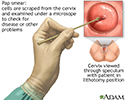Cervical cancer - screening and prevention
Cancer cervix - screening; HPV - cervical cancer screening; Dysplasia - cervical cancer screening; Cervical cancer - HPV vaccine
Cervical cancer is a cancer that starts in the cervix. The cervix is the lower part of the uterus (womb) that opens at the top of the vagina.
Cervical cancer
Cervical cancer is cancer that starts in the cervix. The cervix is the lower part of the uterus (womb) that opens at the top of the vagina.

There is a lot you can do to decrease your chance of having cervical cancer. Also, your health care provider can do tests to find early changes that may lead to cancer, or to find cervical cancer in the early stages.
Lifestyle and Safer Sex Habits
Almost all cervical cancers are caused by HPV (human papilloma virus).
- HPV is a common virus that spreads through sexual contact.
- Certain types of HPV are more likely to lead to cervical cancer. These are called high-risk types of HPV.
- Other types of HPV cause genital warts.
HPV can be passed from person to person even when there are no visible warts or other symptoms.
Vaccines to Prevent Cervical Cancer
A vaccine is available to protect against the HPV types that cause most cervical cancer in women. The vaccine is:
- Given as a series of 2 shots.
- Recommended for girls and women ages 9 through 26.
- Best for girls to get by age 11 or before becoming sexually active. However, girls and younger women who are already sexually active can still be protected by the vaccine.
These safer sex practices can also help reduce your risk of getting HPV and cervical cancer:
- Always use condoms. But be aware that condoms cannot fully protect you. This is because the virus or warts can also be on the nearby skin.
- Have only one sexual partner, whom you know is infection-free.
- Limit the number of sexual partners you have over time.
- DO NOT get involved with partners who take part in high-risk sexual activities.
- DO NOT smoke. Cigarette smoking increases the risk of getting cervical cancer.
Pap Smears
Cervical cancer usually develops slowly. It starts as precancerous changes called dysplasia . Dysplasia can be detected by a medical test called a Pap smear .
Dysplasia
Cervical dysplasia refers to abnormal changes in the cells on the surface of the cervix. The cervix is the lower part of the uterus (womb) that open...

Pap smear
The Pap test checks for cervical cancer. Cells scraped from the opening of the cervix are examined under a microscope. The cervix is the lower part...

Dysplasia is fully treatable. That is why it is important for women to get regular Pap smears, so that precancerous cells can be removed before they can become cancer.
Pap smear screening should start at age 21. After the first test:
- Women ages 21 through 29 should have a Pap smear every 3 years.
- Women ages 30 through 65 should be screened with either a Pap smear every 3 years or a Pap smear and HPV test every 5 years.
- If you or your sexual partner has other new partners, you should have a Pap smear every 3 years.
- Women ages 65 through 70 can stop having Pap smears as long as they have had 3 normal tests within the past 10 years.
- Women who have been treated for precancer (cervical dysplasia) should continue to have Pap smears for 20 years after treatment or until age 65, whichever is longer.
Talk with your provider about how often you should have a Pap smear.
References
CDC recommends only two HPV shots for younger adolescents [press release]. Atlanta, GA: Centers for Disease Control and Prevention Media Relations; October 19, 2016. www.cdc.gov/media/releases/2016/p1020-hpv-shots.html . Accessed December 7, 2016.
Committee on Adolescent Health Care of the American College of Obstetricians and Gynecologists; Immunization Expert Work Group of the American College of Obstetricians and Gynecologists. Committee opinion no. 588: human papillomavirus vaccination. Obstet Gynecol . 2014;123(3):712-718. PMID: 24553168 www.ncbi.nlm.nih.gov/pubmed/24553168 .
Kim DK, Bridges CB, Harriman KH; Centers for Disease Control and Prevention (CDC); Advisory Committee on Immunization Practices (ACIP); ACIP Adult Immunization Work Group. Advisory committee on immunization practices recommended immunization schedule for adults aged 19 years or older--United States, 2015. MMWR Morb Mortal Wkly Rep . 2015;64(4):91-92. PMID: 25654609 www.ncbi.nlm.nih.gov/pubmed/25654609 .
Noller KL. Intraepithelial neoplasia of the lower genital tract (cervix, vulva): etiology, screening, diagnostic techniques, management. In: Lentz GM, Lobo RA, Gershenson DM, Katz VL, eds. Comprehensive Gynecology . 6th ed. Philadelphia, PA: Elsevier Mosby; 2012:chap 28.
Saslow D, Solomon D, Lawson HW, et al. American Cancer Society, American Society for Colposcopy and Cervical Pathology, and American Society for Clinical Pathology screening guidelines for the prevention and early detection of cervical cancer. CA Cancer J Clin . 2012;62(3):147-172. PMID: 22422631 www.ncbi.nlm.nih.gov/pubmed/22422631 .
US Preventive Services Task Force. Cervical cancer: screening. USPSTF.org Web site. www.uspreventiveservicestaskforce.org/uspstf/uspscerv.htm . Accessed December 7, 2016.
-
Pap smear - illustration
A Pap test is a simple, relatively inexpensive procedure that can easily detect cancerous or precancerous conditions.
Pap smear
illustration
-
Cervical dysplasia
(Alt. Medicine)
-
Ovarian cancer
(In-Depth)
-
Colon and rectal cancers
(In-Depth)
-
Vitamin B9 (Folic acid)
(Alt. Medicine)
-
Smoking
(In-Depth)
-
Hodgkin disease
(In-Depth)
-
Psoriasis
(In-Depth)
Review Date: 11/5/2015
Reviewed By: Cynthia D. White, MD, Fellow American College of Obstetricians and Gynecologists, Group Health Cooperative, Bellevue, WA. Also reviewed by David Zieve, MD, MHA, Isla Ogilvie, PhD, and the A.D.A.M. Editorial team. Editorial update 12/07/2016.

